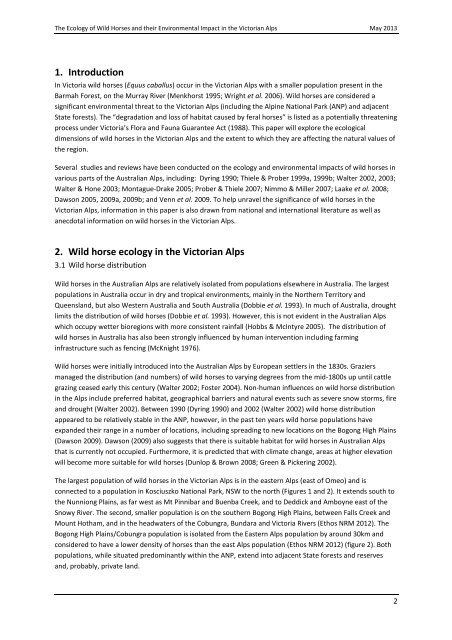The Ecology of Wild Horses and their Environmental ... - Parks Victoria
The Ecology of Wild Horses and their Environmental ... - Parks Victoria
The Ecology of Wild Horses and their Environmental ... - Parks Victoria
Create successful ePaper yourself
Turn your PDF publications into a flip-book with our unique Google optimized e-Paper software.
<strong>The</strong> <strong>Ecology</strong> <strong>of</strong> <strong>Wild</strong> <strong>Horses</strong> <strong>and</strong> <strong>their</strong> <strong>Environmental</strong> Impact in the <strong>Victoria</strong>n Alps May 20131. IntroductionIn <strong>Victoria</strong> wild horses (Equus caballus) occur in the <strong>Victoria</strong>n Alps with a smaller population present in theBarmah Forest, on the Murray River (Menkhorst 1995; Wright et al. 2006). <strong>Wild</strong> horses are considered asignificant environmental threat to the <strong>Victoria</strong>n Alps (including the Alpine National Park (ANP) <strong>and</strong> adjacentState forests). <strong>The</strong> “degradation <strong>and</strong> loss <strong>of</strong> habitat caused by feral horses” is listed as a potentially threateningprocess under <strong>Victoria</strong>’s Flora <strong>and</strong> Fauna Guarantee Act (1988). This paper will explore the ecologicaldimensions <strong>of</strong> wild horses in the <strong>Victoria</strong>n Alps <strong>and</strong> the extent to which they are affecting the natural values <strong>of</strong>the region.Several studies <strong>and</strong> reviews have been conducted on the ecology <strong>and</strong> environmental impacts <strong>of</strong> wild horses invarious parts <strong>of</strong> the Australian Alps, including: Dyring 1990; Thiele & Prober 1999a, 1999b; Walter 2002, 2003;Walter & Hone 2003; Montague-Drake 2005; Prober & Thiele 2007; Nimmo & Miller 2007; Laake et al. 2008;Dawson 2005, 2009a, 2009b; <strong>and</strong> Venn et al. 2009. To help unravel the significance <strong>of</strong> wild horses in the<strong>Victoria</strong>n Alps, information in this paper is also drawn from national <strong>and</strong> international literature as well asanecdotal information on wild horses in the <strong>Victoria</strong>n Alps.2. <strong>Wild</strong> horse ecology in the <strong>Victoria</strong>n Alps3.1 <strong>Wild</strong> horse distribution<strong>Wild</strong> horses in the Australian Alps are relatively isolated from populations elsewhere in Australia. <strong>The</strong> largestpopulations in Australia occur in dry <strong>and</strong> tropical environments, mainly in the Northern Territory <strong>and</strong>Queensl<strong>and</strong>, but also Western Australia <strong>and</strong> South Australia (Dobbie et al. 1993). In much <strong>of</strong> Australia, droughtlimits the distribution <strong>of</strong> wild horses (Dobbie et al. 1993). However, this is not evident in the Australian Alpswhich occupy wetter bioregions with more consistent rainfall (Hobbs & McIntyre 2005). <strong>The</strong> distribution <strong>of</strong>wild horses in Australia has also been strongly influenced by human intervention including farminginfrastructure such as fencing (McKnight 1976).<strong>Wild</strong> horses were initially introduced into the Australian Alps by European settlers in the 1830s. Graziersmanaged the distribution (<strong>and</strong> numbers) <strong>of</strong> wild horses to varying degrees from the mid-1800s up until cattlegrazing ceased early this century (Walter 2002; Foster 2004). Non-human influences on wild horse distributionin the Alps include preferred habitat, geographical barriers <strong>and</strong> natural events such as severe snow storms, fire<strong>and</strong> drought (Walter 2002). Between 1990 (Dyring 1990) <strong>and</strong> 2002 (Walter 2002) wild horse distributionappeared to be relatively stable in the ANP, however, in the past ten years wild horse populations haveexp<strong>and</strong>ed <strong>their</strong> range in a number <strong>of</strong> locations, including spreading to new locations on the Bogong High Plains(Dawson 2009). Dawson (2009) also suggests that there is suitable habitat for wild horses in Australian Alpsthat is currently not occupied. Furthermore, it is predicted that with climate change, areas at higher elevationwill become more suitable for wild horses (Dunlop & Brown 2008; Green & Pickering 2002).<strong>The</strong> largest population <strong>of</strong> wild horses in the <strong>Victoria</strong>n Alps is in the eastern Alps (east <strong>of</strong> Omeo) <strong>and</strong> isconnected to a population in Kosciuszko National Park, NSW to the north (Figures 1 <strong>and</strong> 2). It extends south tothe Nunniong Plains, as far west as Mt Pinnibar <strong>and</strong> Buenba Creek, <strong>and</strong> to Deddick <strong>and</strong> Amboyne east <strong>of</strong> theSnowy River. <strong>The</strong> second, smaller population is on the southern Bogong High Plains, between Falls Creek <strong>and</strong>Mount Hotham, <strong>and</strong> in the headwaters <strong>of</strong> the Cobungra, Bundara <strong>and</strong> <strong>Victoria</strong> Rivers (Ethos NRM 2012). <strong>The</strong>Bogong High Plains/Cobungra population is isolated from the Eastern Alps population by around 30km <strong>and</strong>considered to have a lower density <strong>of</strong> horses than the east Alps population (Ethos NRM 2012) (figure 2). Bothpopulations, while situated predominantly within the ANP, extend into adjacent State forests <strong>and</strong> reserves<strong>and</strong>, probably, private l<strong>and</strong>.2
















